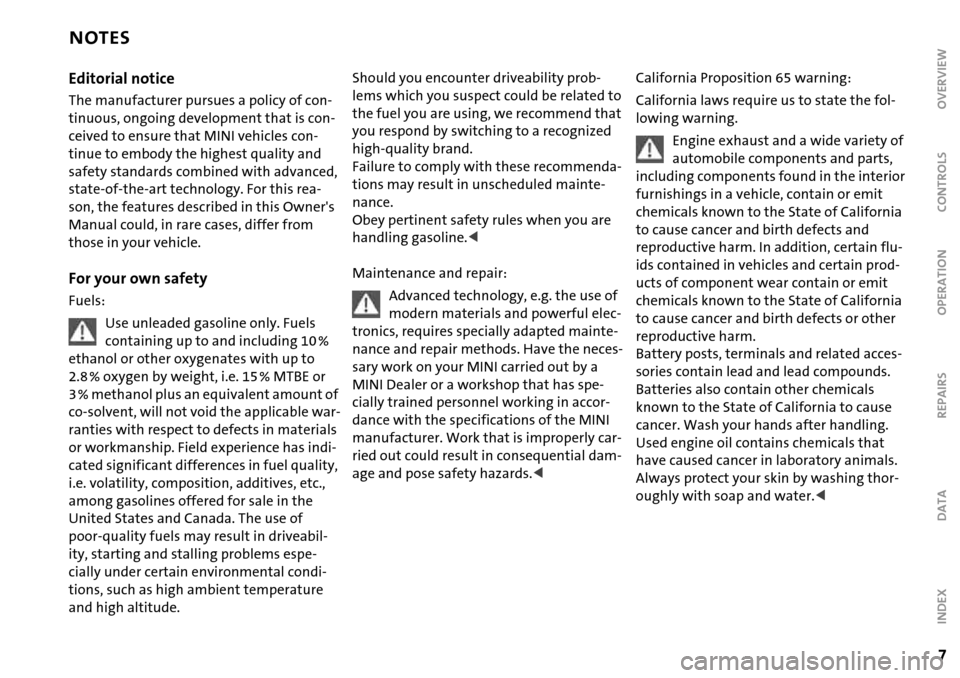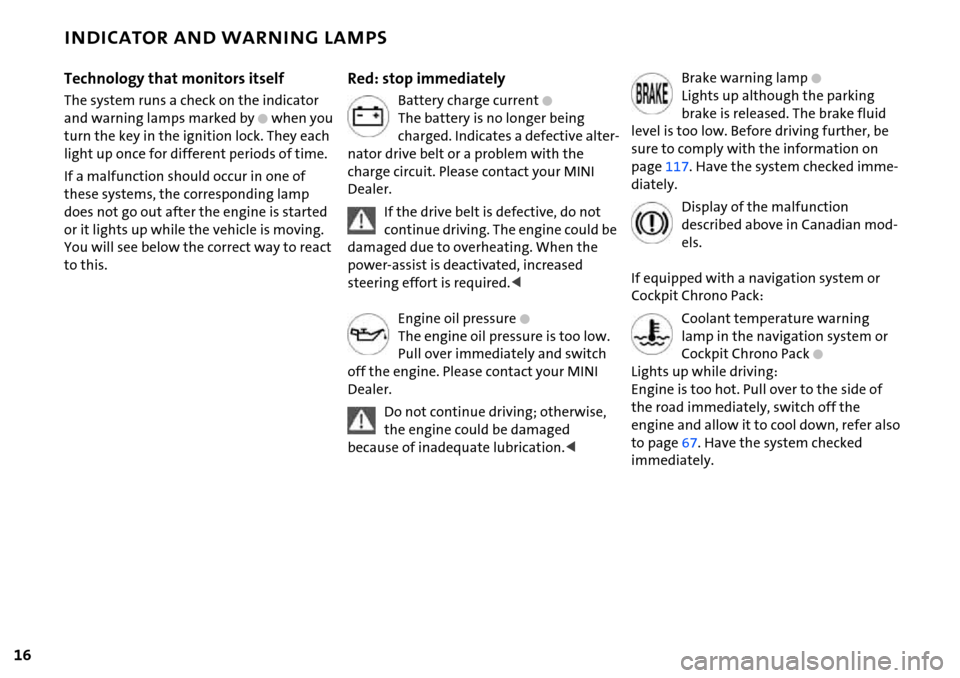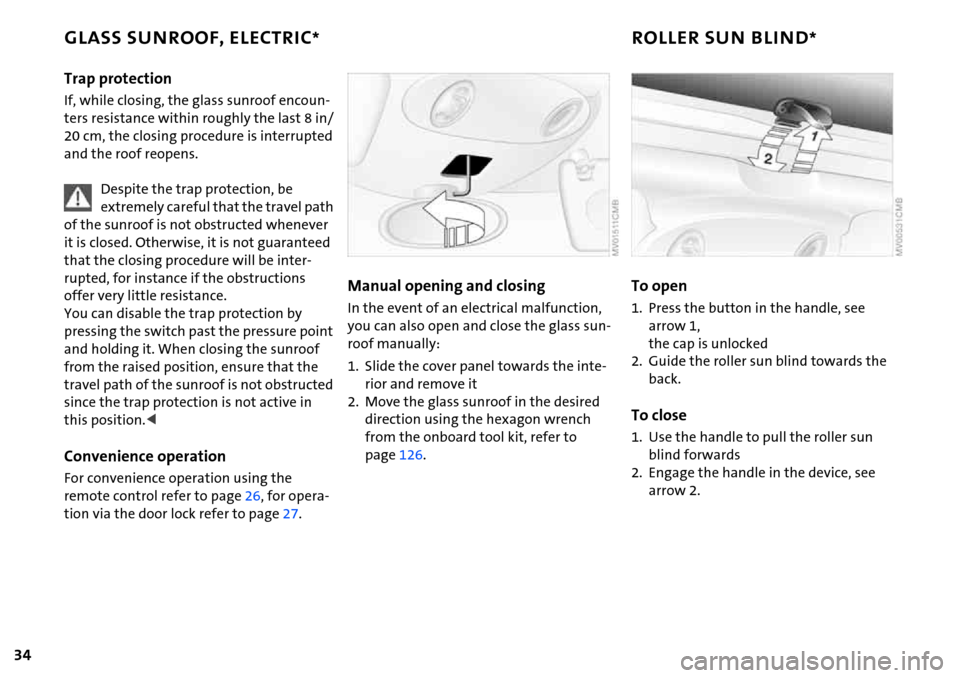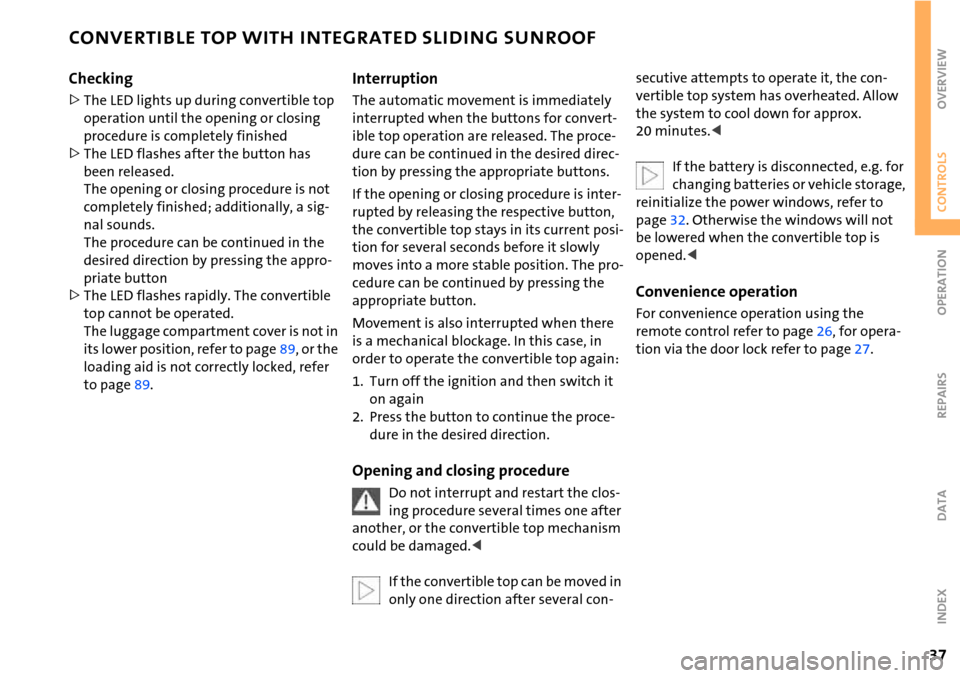ESP MINI Hardtop 2 Door 2006 Owner's Manual
[x] Cancel search | Manufacturer: MINI, Model Year: 2006, Model line: Hardtop 2 Door, Model: MINI Hardtop 2 Door 2006Pages: 168, PDF Size: 2.22 MB
Page 9 of 168

7
OVERVIEW REPAIRS OPERATION CONTROLS DATA INDEX
Editorial notice
The manufacturer pursues a policy of con-
tinuous, ongoing development that is con-
ceived to ensure that MINI vehicles con-
tinue to embody the highest quality and
safety standards combined with advanced,
state-of-the-art technology. For this rea-
son, the features described in this Owner's
Manual could, in rare cases, differ from
those in your vehicle.
For your own safety
Fuels:
Use unleaded gasoline only. Fuels
containing up to and including 10 %
ethanol or other oxygenates with up to
2.8 % oxygen by weight, i.e. 15 % MTBE or
3 % methanol plus an equivalent amount of
co-solvent, will not void the applicable war-
ranties with respect to defects in materials
or workmanship. Field experience has indi-
cated significant differences in fuel quality,
i.e. volatility, composition, additives, etc.,
among gasolines offered for sale in the
United States and Canada. The use of
poor-quality fuels may result in driveabil-
ity, starting and stalling problems espe-
cially under certain environmental condi-
tions, such as high ambient temperature
and high altitude.
Should you encounter driveability prob-
lems which you suspect could be related to
the fuel you are using, we recommend that
you respond by switching to a recognized
high-quality brand.
Failure to comply with these recommenda-
tions may result in unscheduled mainte-
nance.
Obey pertinent safety rules when you are
handling gasoline.<
Maintenance and repair:
Advanced technology, e.g. the use of
modern materials and powerful elec-
tronics, requires specially adapted mainte-
nance and repair methods. Have the neces-
sary work on your MINI carried out by a
MINI Dealer or a workshop that has spe-
cially trained personnel working in accor-
dance with the specifications of the MINI
manufacturer. Work that is improperly car-
ried out could result in consequential dam-
age and pose safety hazards.
lowing warning.
Engine exhaust and a wide variety of
automobile components and parts,
including components found in the interior
furnishings in a vehicle, contain or emit
chemicals known to the State of California
to cause cancer and birth defects and
reproductive harm. In addition, certain flu-
ids contained in vehicles and certain prod-
ucts of component wear contain or emit
chemicals known to the State of California
to cause cancer and birth defects or other
reproductive harm.
Battery posts, terminals and related acces-
sories contain lead and lead compounds.
Batteries also contain other chemicals
known to the State of California to cause
cancer. Wash your hands after handling.
Used engine oil contains chemicals that
have caused cancer in laboratory animals.
Always protect your skin by washing thor-
oughly with soap and water.<
NOTES
Page 18 of 168

16
INDICATOR AND WARNING LAMPS
Technology that monitors itself
The system runs a check on the indicator
and warning lamps marked by
+ when you
turn the key in the ignition lock. They each
light up once for different periods of time.
If a malfunction should occur in one of
these systems, the corresponding lamp
does not go out after the engine is started
or it lights up while the vehicle is moving.
You will see below the correct way to react
to this.
Red: stop immediately
Battery charge current+
The battery is no longer being
charged. Indicates a defective alter-
nator drive belt or a problem with the
charge circuit. Please contact your MINI
Dealer.
If the drive belt is defective, do not
continue driving. The engine could be
damaged due to overheating. When the
power-assist is deactivated, increased
steering effort is required.<
Engine oil pressure
+
The engine oil pressure is too low.
Pull over immediately and switch
off the engine. Please contact your MINI
Dealer.
Do not continue driving; otherwise,
the engine could be damaged
because of inadequate lubrication.<
Brake warning lamp+
Lights up although the parking
brake is released. The brake fluid
level is too low. Before driving further, be
sure to comply with the information on
page117. Have the system checked imme-
diately.
Display of the malfunction
described above in Canadian mod-
els.
If equipped with a navigation system or
Cockpit Chrono Pack:
Coolant temperature warning
lamp in the navigation system or
Cockpit Chrono Pack
+
Lights up while driving:
Engine is too hot. Pull over to the side of
the road immediately, switch off the
engine and allow it to cool down, refer also
to page67. Have the system checked
immediately.
Page 30 of 168

28
OPENING AND CLOSING: FROM INSIDE
This switch locks or unlocks the doors and
tailgate when the front doors are closed,
but the anti-theft system is not activated.
The fuel filler door remains unlocked.
To lock
>Briefly press the switch downward or
>push down the safety lock button on the
passenger door. To prevent yourself from
being locked outside the vehicle acciden-
tally, the driver's door cannot be locked
with its safety lock button while it is
open.
After you have driven off, the central
locking system automatically locks
your vehicle once a certain speed has been
reached.<
You can have this function activated/
deactivated and the speed set.<
People or animals inside the vehicle
could lock the doors from the inside.
Always take the vehicle's keys with you so
that you can open the vehicle again from
the outside at any time.<
To unlock and open the doors
1. Briefly press the switch upward
2. Pull the respective door handle over the
armrest or pull the door handle for each
door twice:
The first pull unlocks the door, the sec-
ond pull opens it.
Convenience opening mode
Press the central locking switch and hold it
pressed.
MINI:
Windows and glass sunroof are opened.
MINI Convertible:
Windows and sliding sunroof are opened.
To open the convertible top:
Release the switch, then press it upwards
until the convertible top is completely open
and the windows are again closed.
Page 36 of 168

34
GLASS SUNROOF, ELECTRIC*ROLLER SUN BLIND*
Trap protection
If, while closing, the glass sunroof encoun-
ters resistance within roughly the last 8 in/
20 cm, the closing procedure is interrupted
and the roof reopens.
Despite the trap protection, be
extremely careful that the travel path
of the sunroof is not obstructed whenever
it is closed. Otherwise, it is not guaranteed
that the closing procedure will be inter-
rupted, for instance if the obstructions
offer very little resistance.
You can disable the trap protection by
pressing the switch past the pressure point
and holding it. When closing the sunroof
from the raised position, ensure that the
travel path of the sunroof is not obstructed
since the trap protection is not active in
this position.<
Convenience operation
For convenience operation using the
remote control refer to page26, for opera-
tion via the door lock refer to page27.
Manual opening and closing
In the event of an electrical malfunction,
you can also open and close the glass sun-
roof manually:
1. Slide the cover panel towards the inte-
rior and remove it
2. Move the glass sunroof in the desired
direction using the hexagon wrench
from the onboard tool kit, refer to
page126.
To open
1. Press the button in the handle, see
arrow 1,
the cap is unlocked
2. Guide the roller sun blind towards the
back.
To close
1. Use the handle to pull the roller sun
blind forwards
2. Engage the handle in the device, see
arrow 2.
Page 39 of 168

37
OVERVIEW REPAIRS OPERATIONCONTROLS DATA INDEX
CONVERTIBLE TOP WITH INTEGRATED SLIDING SUNROOF
Checking
>The LED lights up during convertible top
operation until the opening or closing
procedure is completely finished
>The LED flashes after the button has
been released.
The opening or closing procedure is not
completely finished; additionally, a sig-
nal sounds.
The procedure can be continued in the
desired direction by pressing the appro-
priate button
>The LED flashes rapidly. The convertible
top cannot be operated.
The luggage compartment cover is not in
its lower position, refer to page89, or the
loading aid is not correctly locked, refer
to page89.
Interruption
The automatic movement is immediately
interrupted when the buttons for convert-
ible top operation are released. The proce-
dure can be continued in the desired direc-
tion by pressing the appropriate buttons.
If the opening or closing procedure is inter-
rupted by releasing the respective button,
the convertible top stays in its current posi-
tion for several seconds before it slowly
moves into a more stable position. The pro-
cedure can be continued by pressing the
appropriate button.
Movement is also interrupted when there
is a mechanical blockage. In this case, in
order to operate the convertible top again:
1. Turn off the ignition and then switch it
on again
2. Press the button to continue the proce-
dure in the desired direction.
Opening and closing procedure
Do not interrupt and restart the clos-
ing procedure several times one after
another, or the convertible top mechanism
could be damaged.<
If the convertible top can be moved in
only one direction after several con-
secutive attempts to operate it, the con-
vertible top system has overheated. Allow
the system to cool down for approx.
20 minutes.<
If the battery is disconnected, e.g. for
changing batteries or vehicle storage,
reinitialize the power windows, refer to
page32. Otherwise the windows will not
be lowered when the convertible top is
opened.<
Convenience operation
For convenience operation using the
remote control refer to page26, for opera-
tion via the door lock refer to page27.
Page 41 of 168

39
OVERVIEW REPAIRS OPERATIONCONTROLS DATA INDEX
CONVERTIBLE TOP WITH INTEGRATED SLIDING SUNROOF
Releasing the convertible top
Depending on the vehicle model, it
may also be necessary to release the
convertible top in order to close it.<
1. Press the lever with the hexagon wrench
to release the convertible top, see arrow
1, and lift the side frame, see arrow 2.
If necessary, insert an object between
that side frame and the body to prevent
the convertible top from locking again
2. Release the second side frame.
Closing the convertible top
If possible, close the convertible top
with the help of a second person.<
1. Place both hands on the convertible top
on the respective side frame
2. Lift out both sides at the same time, and
swing the convertible top forward onto
the cowl
3. Inside the vehicle, use a screwdriver to
pry out the cover in the center of the
roof.
To close the sliding sunroof
1. Insert the hexagon wrench into the des-
ignated socket in the middle of the roof
2. Knock the hexagon wrench in the direc-
tion of arrow 1 to uncouple the sliding
sunroof mechanism. The hexagon
wrench moves upwards
3. Turn the hexagon wrench in the direc-
tion of arrow 2.
To lock the convertible top
Continue to turn the hexagon wrench until
the convertible top is locked in place.
Please contact your MINI Dealer to
have the electrical malfunction
repaired.<
Page 42 of 168

40
WIND DEFLECTOR*
With the convertible top open, the wind
deflector keeps air movement in the pas-
senger compartment to a minimum, thus
providing you with a pleasant drive, even at
higher speeds. The wind deflector comes
folded in a protective pouch and can be
stored in the luggage compartment.
Do not allow the wind deflector to
come into contact with sharp objects,
as the net could otherwise be damaged. Do
not place any objects on the installed wind
deflector. When storing the wind deflector
in the luggage compartment, make sure
that it cannot be damaged by other
objects.<
Before installing
1. Take the wind deflector out of the pouch
2. Fold out the wind deflector, arrow 1
3. Press the locking device together until it
engages, arrow 2.
Installing and folding up
1. Slide out securing pins 1 and 2 on one
side until they engage
2. Insert the wind deflector with the secur-
ing pins into the designated openings on
the corresponding side of the vehicle
3. Slide securing pins 1 and 2 on the other
side into the designated openings until
they engage
4. Fold up the upper part of the wind
deflector.
If a seat is in its rearmost position, do
not recline the backrest too far, oth-
erwise the wind deflector could be dam-
aged.<
Page 45 of 168

43
OVERVIEW REPAIRS OPERATIONCONTROLS DATA INDEX
SEAT ADJUSTMENT
Important adjustment information
Never try to adjust your seat while
operating the vehicle. The seat could
respond with an unexpected movement,
and the ensuing loss of vehicle control
could lead to an accident.
While driving, do not recline the backrest
too far toward the rear; this especially
applies to the front passenger seat. Other-
wise there is a risk that you will slide under
the safety belt in an accident, thus reducing
the protection provided by the safety
belt.<
Comply with the instructions on head
restraint height adjustment on page44
and on damaged safety belts on page47.
Longitudinal adjustment
1. Lift the handle
2. Push the seat into the desired position
3. After releasing the handle, apply pres-
sure to the seat to ensure that the latch
engages securely.
Height adjustment
1. To raise:
Pull the handle up repeatedly, continu-
ing until the seat reaches the desired
height
2. To lower:
Push the handle repeatedly, continuing
until the seat reaches the desired height.
Page 54 of 168

52
TRANSPORTING CHILDREN SAFELY
LATCH child-restraint fixing system
LATCH: Lower Anchor and Tethers for CHil-
dren.
The anchor points for the LATCH child-
restraint fixing system are behind the
marked cover caps. Flip up the correspond-
ing cover caps.
To mount a LATCH child-restraint sys-
tem, follow the system manufac-
turer's operating and safety instructions.<
Page 61 of 168

59
OVERVIEW REPAIRS OPERATIONCONTROLS DATA INDEX
PARKING LAMPS/LOW BEAMS
1 Parking lamps
2 Low beams
3 Automatic headlamp control
*
Parking lamps
Turn the light switch to position 1.
The front, rear and side vehicle
lighting is switched on.
For the additional option of activating the
lights on one side of the vehicle for parking,
refer to Switching on the standing lamps,
page59.
The parking lamps discharge the bat-
tery.
Avoid using them for longer periods of
time; otherwise, you may not be able to
start the engine.<
Low beams
Turn the light switch to position 2.
With the low beams on and with
the ignition switched off, only the
parking lamps will remain on.
Automatic headlamp control*
In switch position 3, the system
automatically activates and can-
cels the low beams in response to
changes in ambient light, for example in
tunnels, at dusk, and when there is precipi-
tation.
When driving into a tunnel with bright
overhead lights, there may be a delay
before the low beams come on.
The low beams may also come on when the
sun is sitting low on a blue sky.
When you switch on the fog lamps,
the low-beam headlamps remain on
regardless of the ambient light. When the
daytime driving lamps are activated, refer
to page60, the low beams come on and
remain lit when the switch is in position 1
and the ignition is switched on.<
Automatic headlamp control cannot
serve as a substitute for the driver's
judgement in determining when the vehi-
cle lights should be switched on. For exam-
ple, the sensors are not able to detect fog.
To avoid safety risks, you should respond to
these kinds of low-visibility situations by
switching the headlamps on manually.<
You can have the sensitivity of your
vehicle's automatic headlamp con-
trol adjusted.<
Pathway lighting
If you activate the headlamp flasher after
having switched off the engine and the
lights, the low beams will stay lit for a pre-
set period of time.
You can have this function pro-
grammed.<
Switching on the standing lamps
For parking, you can activate lights on one
side of the vehicle. Observe local laws.
In ignition key position 0:
Move the lever to the adequate turn signal
indicator position.
The standing lamps discharge the
battery. Avoid using them for longer
periods of time; otherwise, you may not be
able to start the engine.<